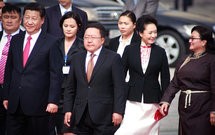 On 22 August, Chinese President Xi Jinping wrapped up his two-day trip to Mongolia, which is noteworthy not just because he signed as many as 26 agreements but because this was his second single country visit since he became President and also a first by a head of state after 11 years. This raises questions about why Mongolia has acquired special attention in Xi’s foreign policy and whether this indicates a new shift.
On 22 August, Chinese President Xi Jinping wrapped up his two-day trip to Mongolia, which is noteworthy not just because he signed as many as 26 agreements but because this was his second single country visit since he became President and also a first by a head of state after 11 years. This raises questions about why Mongolia has acquired special attention in Xi’s foreign policy and whether this indicates a new shift.
Looking at the bare facts, the current visit suggests quite a few breakthroughs in the economic, political and diplomatic arenas. The visit saw an up-gradation of China-Mongolia relations from ‘good-neighbourly and mutual trust’ in 2003 to ‘a strategic partnership’ in 2011 to the present ‘comprehensive strategic partnership’. Under the rubric of comprehensive strategic partnership, China agreed to provide land-locked Mongolia additional access to Chinese seaports as well as access to railway networks for transportation of goods. It agreed to support a number of projects in medical care, education, railroads and other infrastructure construction. Further, China inked a proposal to set up a bilateral free trade zone and currency swap arrangements. Besides, the two sides targeted to achieve US$10 billion trade by 2020. More importantly, while Mongolia agreed to join China’s Silk Road Economic Belt, Beijing extended an invitation to Ulaanbaatar to the APEC meeting slated for November in Shanghai.
Gauging the achievements, one is tempted to reach the conclusion that the Sino-Mongolian relationship has certainly acquired a new momentum. However, this is not entirely the case. China had outwitted Russia in becoming the largest investor in Mongolia in 1998 and the largest trading partner in 1999. This deepening of ties was in tandem with changes in Mongolia-Russia relations post the Cold War era. The Soviet collapse precipitated a shift in Mongolia’s foreign policy to adopting an omni-enmeshment policy. This meant first putting a stop to one-sided reliance on Russia and normalisation of its relations with China, and second, reaching out to other powers, primarily the US as underscored in its ‘third neighbour’ strategy. Simply put, China’s dominance on Mongolia’s economy in terms of trade and investment is not a new phenomenon.
Rather, economic over-dependence on China has alerted Mongolia to reconstitute its foreign policy and adopt a new strategy in 2011 that Jeffrey Reeves has called the ‘omni-enmeshment and balance of influence’ approach. This new approach called for engaging not only a number of great powers through multilateral and bilateral mechanisms but also balancing against one country through triangular politics. Evidently thus, Mongolia signed the strategic partnership with the US in 2013. It expanded defence ties with India in 2011 much to the concern of China. This new policy thrust though does not lessen its economic dependence on China, however, it does accrue deterrence for Mongolia.
It is pertinent to note that Mongolia’s geographical location, sandwiched between China and Russia, poses a formidable challenge. Bereft of an opening to the sea, it is forced to depend on its immediate neighbours. But depending on China for access to seaports is more cost-effective than depending on Russia. As one study shows, the Russian port of Vladivostok is 3000 miles away from Mongolia’s rich Tavan Tolgoi coal mine, while the Chinese port of Tianjin is barely 1,000 miles away. Naturally, Mongolia has no option but to depend on China.
However, Mongolia fears that closer connections with China that would allow the latter to dominate in its domestic matters, as had happened in the past when the Dalai Lama’s visit to Ulaanbaatar annoyed the Chinese and led the border to be closed, hurting Monglian trade in the process. But China too has its own vulnerabilities. One is the presence of the US in Mongolia as a ‘third neighbour’. Two is the potential influence of Mongolian nationalism on its own five million ethnic Mongolians living in Inner Mongolia. And three, it has concerns regarding the Tibet issue as 92 per cent of Mongolian people follow Buddhism and consider the Dalai Lama their religious leader.
While these vulnerabilities have been around for quite some time, the current fillip to China’s Mongolia thrust has come from the US rebalancing strategy under Barack Obama that in turn has reinforced Mongolia’s ‘third neighbour’ strategy. To this, Xi Jinping has retaliated with a new foreign policy initiative. As articulated by a noted Chinese scholar, Yan Xuetong, this new initiative instead of ascribing top priority to China’s relations with the US, emphasises on giving first priority to its relations with neighbouring countries. Xi Jinping thus, went to Mongolia to sell his dream of the New Silk Road economic belt. Outlining the need for China and Mongolia to be good neighbours and support each other, his 22 August speech in Mongolia offered sops including Mongolia’s bid for membership in the APEC and acceptance for the Ulaanbaatar proposal for a trilateral summit, involving Mongolia, Russia and China. Also, Xi tried to assuage Mongolians’ fear about Chinese intentions and reiterated China’s peaceful development and win-win strategy.
Clearly, Xi’s visit was intended to enlist the support of Mongolia in fulfilling the Chinese dream, but Mongolia like most other China’s neighbours while eager to engage economically, is not sanguine of Chinese intentions.
By Special Arrangement with Institute of Peace and Conflict Studies (http://www.ipcs.org)